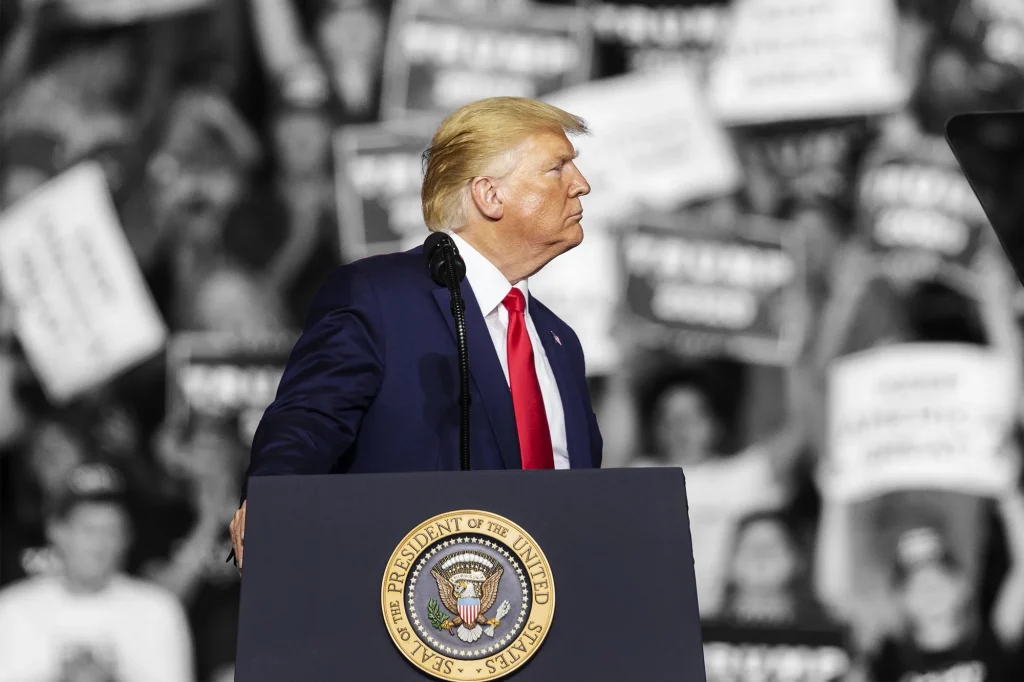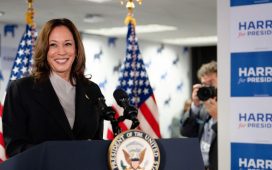
With less than two months until 2024’s general election, the Presidential race appears as heated as ever. The daily news features campaign coverage of the Democratic nominee, Vice President Kamala Harris, and Republican nominee, former President Donald Trump.
The prospect of Trump winning this election has huge implications for global markets as investors brace for a potential return of the “Trump trade” dynamics seen during his first term in office.
Trump’s unorthodox and protectionist approach to foreign relations and his willingness to confront both allies and adversaries proved tumultuous yet lucrative for some investors attuned to positioning for his policies will increase his chances of becoming the US president.
This is an improvement from the 39 percent chance the Republican was given by 538 on September 17—the first time Trump dropped below 40 percent in the 538 election forecast model —whereas Harris has dropped from 61 percent chance of victory.
But what precisely defined the Trump trade, and how might it evolve if he captured the presidency once more? Answering these questions requires examining Trump’s relationships with major geopolitical actors like NATO, China, and Russia during his first administration and assessing the impact a potential leadership style change could have on asset prices worldwide.
Understanding the Trump Trade
When Trump surprisingly won the 2016 election, markets were caught off guard. No one knew what his “America First” foreign policy approach would look like. At first, there was uncertainty. Soon though, clear trends emerged as investors made bets on how Trump may run things. In the U.S.
During Trump’s first term, the markets exhibited several distinct trends:
- Soaring Stock Prices: U.S. stocks, especially in the technology, finance, industrial, and energy sectors, saw substantial gains. This was largely attributed to Trump’s pro-business agenda, which included the Tax Cuts and Jobs Act of 2017. This act reduced corporate tax rates, leading to increased investments, stock buybacks, and dividends.
- Rising Treasury Yields: Expectations of increased government spending and a more hawkish Federal Reserve under the Trump administration led to a rise in Treasury yields. this happened because Trump talked about big infrastructure projects and military spending that would add to the national debt. Higher rates were needed to attract buyers for more government bonds to pay for it all. The 10-year U.S. Treasury yield climbed from 1.82% in November 2016 to 3.23% in November 2018, before dropping as recession fears grew due to tightened monetary policies.
- Stronger US Dollar: Overseas, currencies, and commodity prices moved up and down depending on how countries may be affected by Trump. The U.S. dollar grew stronger compared to currencies from Europe and other places. This was because interest rates in the U.S. were expected to increase more under Trump to deal with extra inflation from more government spending and individual spending which also allows you to place bets at 22Bet for sweet stronger US dollars.
Investors began referring to this overall pattern of moves in stock markets, currencies, commodity prices, and interest rates as the “Trump trade.” This was because savvy traders positioned themselves based on how they thought Trump would impact different parts of the financial world as President. Some people made a lot of money by correctly guessing which direction things would move at first. Of course, not all the trends lasted, as trade wars caused turbulence later. But the “Trump trade” concept captured how the marketplace reacted to the new uncertainties of Trump’s presidency.
What Would Trump 2.0 Mean For The Financial Markets
Trump was unpredictable in dealing with important countries and groups like NATO, China, and Russia. How he may act in a second term could heavily influence markets:
Relationship with NATO
The North Atlantic Treaty Organization (NATO) consists of 32 member countries and has been a military alliance protecting Europe since World War II. The United States covers about 22% of NATO’s budget, and fair burden-sharing among NATO members has been a long-standing concern. In 2014, NATO set a goal for each member to spend 2% of their economy on defense budgets. At the time, only three countries, including the US, met that target.
During his presidency, Trump frequently criticized European NATO members for not contributing enough money. His words sometimes caused stock and currency markets in Europe to become unstable and nervous. Investors were worried about Trump openly attacking allies and the future of NATO, which has brought stability for a long time.
At one point, Trump considered leaving NATO over this issue, which scared European leaders and others. However, his supporters argue that because of his threats, more NATO countries hit the 2% spending target since then to strengthen the alliance.
If Trump is re-elected as president, it is expected that he will continue his tough stance with NATO members. This may lead to volatility in the equity and currency markets. Extreme statements from Trump about NATO may create increased uncertainty over US membership in NATO, which could have implications for global financial markets. Supporters of Trump would argue that his bark is worse than his bite and not every provocative statement becomes policy, but the financial markets have been sensitive to threats from Trump against European allies.
A Friend of Putin
During his presidency, Trump was often criticized for his seemingly friendly stance toward Russia, particularly his praise of President Putin. This raised concerns among his critics.
Trump was accused by political opponents of being too accommodating to Putin, especially regarding Russia’s annexation of Crimea from Ukraine in 2014. He questioned whether the U.S. should recognize Crimea as Russian territory, which contradicted international commitments to support Ukraine’s sovereignty. This unsettled Ukraine and its allies.
Furthermore, Trump faced criticism for appearing to accept Putin’s denial of interference in the 2016 U.S. election, despite conclusions by American intelligence agencies. A continuation of a warm relationship between the U.S. and Russia under a potential second Trump term could embolden Putin on foreign policy objectives considered destabilizing by Western nations.
If Trump signals less willingness to stand up militarily or economically to Russia’s aggression against neighboring states, countries like Ukraine would remain vulnerable.
In summary, Trump being nice to Russia makes allies near the Russian border feel unsafe. It introduces risks for their stock and currency markets.
Trade War with China
During the Trump presidency, the United States pursued an aggressive trade policy against countries engaging in unfair trade practices, sparking trade wars with China, the European Union, Canada, India, and others.
The most significant trade war was with China, the world’s second-largest economy. President Trump imposed $250 billion in tariffs on a wide range of Chinese imports, prompting China to retaliate with tariffs on American goods. This trade war disrupted global trade and led to increased prices for US consumers and decreased profits for US businesses.
The tariffs made Chinese products more expensive for Americans and negatively impacted industries such as technology, manufacturing, agriculture, and retail. Supply chains for electronics and car companies were disrupted, and US farmers exported fewer soybeans to China. The trade war also affected currency markets, causing fluctuations in exchange rates. Tensions led to a stronger US dollar, while reduced trade tensions improved investor confidence, causing the US dollar to weaken.
In summary, Trump’s aggressive trade policies, particularly with China, resulted in significant market fluctuations and could have similar impacts in the future.
Impact of Trump’s ‘America First’ Doctrine
If Trump becomes president again and continues to disrupt important countries in the same way, it could lead to similarly volatile stock markets as before. During his first presidency, Trump’s confrontational trade policies caused fluctuations in the markets. Additionally, his friendly stance towards Russia caused unease.
Investors became accustomed to significant and unpredictable changes in the market due to Trump’s unconventional foreign policies. As a result, people will closely monitor Trump’s campaign speeches for insights into his foreign policy approach, particularly his “America First” isolationist stance.
Such views could significantly impact global cooperation and the flow of money between nations. The possibility of Trump returning also affects how investors are currently preparing their investments. They are considering the types of investments that performed well during Trump’s previous presidency and are getting ready early in case the “Trump trade” pattern repeats itself. Consequently, markets will closely track Trump’s statements for clues about potential future developments.





